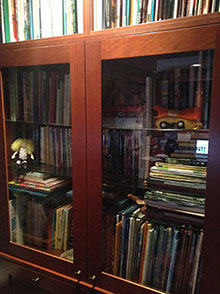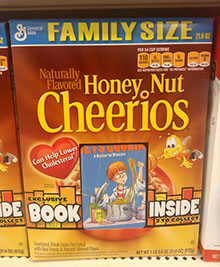“A book is a dream that you hold in your hand.”
—
Neil Gaiman
At home, books line a number of my walls. They spill over into closets... and, okay, even fill a few drawers. I’m perfectly willing to join the de-cluttering movement, until it comes to considering my farewells to the books. It would be like giving the boot to my heroes.
 “Out with you, Lois Lowry and M.T. Anderson and Rebecca Stead! Be gone, Lynne Rae Perkins and Peter Sis, Jacqueline Woodson and Vera Williams and ...” well, at least a hundred other heroes whose work I can’t live without. And that’s only the kid lit which, incidentally, I consider the most important part of my library. The poet Walter de la Mare wrote, “Only the rarest kind of best in anything can be good enough for the young,” I guess that’s why my mantra has always been, “Not just any book will do.” “Out with you, Lois Lowry and M.T. Anderson and Rebecca Stead! Be gone, Lynne Rae Perkins and Peter Sis, Jacqueline Woodson and Vera Williams and ...” well, at least a hundred other heroes whose work I can’t live without. And that’s only the kid lit which, incidentally, I consider the most important part of my library. The poet Walter de la Mare wrote, “Only the rarest kind of best in anything can be good enough for the young,” I guess that’s why my mantra has always been, “Not just any book will do.”
A Boost for Babies
It’s why the gift I give every friend’s or family member’s newborn is a basket filled with baby books. This carefully selected portable library is meant to be hands-on. And I offer it not to ensure that the toddler is decoding print by age three or five, but as the kind of treasure that can light up a little one within. I’m not merely talking about sparking synapses in the brain! Echoing Plutarch’s sentiment, Rabelais put it this way: “A child is not a vase to be filled, but a fire to be lit.” I believe the deep love of books and reading begins in the cradle, not in the classroom.
Children are dependent on grownups, however, to make such access possible, so for years, I made it my business to persuade adults of the transformative power of fine books. Yes, I taught children’s literature at Earlham College, but it was when my firstborn went off to school that I became deeply committed to this form of “evangelism.”
Inspiring a Love of Books
I started a program that spread from her kindergarten classroom to other grades and to other schools in Minnesota. It meant reading and evaluating thousands of books for the Book Nook Program: A Celebration of Children’s Literature (featured in an issue of The Horn Book Magazine). Volunteers gathered the rotating themed collections from the public library for classroom Book Nooks. Kids appreciated the freedom to come to the books with no strings (or quizzes or assigned reading levels) attached. And parents and volunteers read aloud to delighted classes multiple times each week.
These volunteers, many of them parents, partnered with teachers at my series of workshops where I read from and shared insights about books of humor, beauty, and power. They discovered firsthand the difference one or another work of imagination can make in the life of a child. It felt ridiculous, actually, to be paid for the privilege of letting others in on the secret—so many of the books among the brightest of all literary creations. A fan base for the books grew among the grownups, deepening their commitment to sharing them with the young.
 Meanwhile I helped to launch General Mills’ Cheerios campaign—for years guiding selection of books that went into the cereal boxes to support universal literacy and providing guidance to parents at Cheerios.com. Meanwhile I helped to launch General Mills’ Cheerios campaign—for years guiding selection of books that went into the cereal boxes to support universal literacy and providing guidance to parents at Cheerios.com.
Bonding with Books
When early findings about brain imaging came to my attention, revealing the impact of daily read-aloud times dramatically increasing babies’ and toddlers’ brain development, I felt called to respond. My visits to preschool sites at the time confirmed researchers’ claims that book collections and literacy practices were” impoverished.”
I immersed myself in hundreds of board books and picture books for the preschool set. My search was for engaging, language-rich, and age-appropriate gems that also incorporated literary devices like rhyme, repetition, alliteration, and onomatopoeia—elements shown to foster synapse growth in the brain. Research showed that exposure to books and meaningful extended talk had twice the power to enrich young children’s vocabulary than their everyday exposure to conversations of and with parents, caregivers and teachers. The richer the vocabulary, the greater the likelihood of later school success. It saddens me to see how off the mark early childhood literacy practices currently have become with the primacy of flash cards and workbooks and skills testing in lieu of playful and meaningful experiences with books and related activities.
My hope is that well-meaning educators in the field can self-correct and get back to enchanting, amazing, enriching, exploring, and, yes, educating young children, using the best of literature to do so. My wish is that caregivers and parents alike carve out times in every day for a cuddle and a story.
Simply put, the intention—always and in all ways—has been to playfully, joyfully bring kids and the best of books together. It’s this time-honored ritual, among others, that can instill in those lucky enough to experience it, a deep and abiding sense that “life is good.” |

